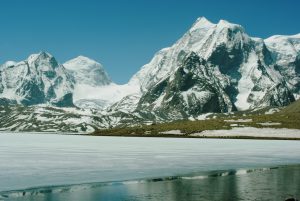Glaciers in India’s northeastern state of Sikkim are melting at a faster rate compared to those in other Himalayan regions, a study has revealed, confirming a development that had been discernible decades ago.
Scientists at the Wadia Institute of Himalayan Geology (WIHG) disclosed recently that glaciers in the Indian state have retreated and deglaciated significantly from 1991 to 2015. While the small-sized glaciers are retreating, the larger ones are thinning due to climate change.
The study assessed the response of 23 glaciers in the border state, where the magnitude of dimensional changes and debris growth were found to be higher since 2000. These glaciers were selected based on multiple criteria such as size, length, debris cover, and slope.
The gist of the report, which was released by the Press Information Bureau (PIB), also mentioned that glaciers in Sikkim have shown negligible deceleration after 2000, which was contrary to the trend discernible in the western and central Himalayas, where glaciers are reported to have slowed down in recent decades.
The research revealed the “heterogeneous” behavior of glaciers in the region, which was found to be primarily determined by size, debris cover, and glacial lakes. Though a generalized mass loss is observed for both small (less than 3 square kilometers) and large-sized glaciers (greater than 10 sq km), they were found to adopt different mechanisms to cope with the ongoing climate change.
So far, extensive studies on glaciers in Sikkim, including field-based mass balance measurements, had been limited to only Changme Khangpu, where research was carried out between 1980 and 1987. The PIB release said that most of the earlier research had been focused on length and area changes only while velocity estimations were hardly studied.
For the first time, the research by Wadia Institute of Himalayan Geology (WIHG) delved into multiple glacier parameters such as length, area, debris cover, snowline altitude, glacial lakes, velocity, and downwasting, and explored the inter-linkage among them to present a clear picture about the status and behavior of glaciers in the state.
The findings are considered significant since in the high mountainous terrains, with the melting of glaciers, the risk of glacial related hazards increases. Sikkim, in particular, is in danger of floods from the glacial lakes – a phenomenon called Glacial Lake Outburst Floods (GLOFs). The retreat of glaciers due to global warming is expected to increase the number of glacial lakes and also expand the size of the existing ones.
Glacial lakes, which are formed when glaciers retreat, can breach suddenly and discharge a huge volume of water and debris. Such outbursts can release millions of cubic meters of water in a brief span of time, causing catastrophic flooding downstream with serious damage to life and property.
In order to prevent such disasters, a project has been launched by the government in the South Lhonak lake where high density polyethylene (HDPE) pipes have been installed to siphon off water from the glacial lake. It is one of the fast-growing lakes out of 14 potentially dangerous lakes susceptible to GLOFs in the Sikkim Himalaya region.
The Pune-based Centre for Development of Advanced Computing (C-DAC) has also begun a scheme to set up an early warning system in Sikkim by deploying field sensors at two lakes on a pilot basis. It will be equipped with real time field sensors for recording increase in the water level in the lakes. The field sensor data will be transmitted through a satellite communication network and will be used in flood simulation models for the prediction of flash floods.
Rajeev Bhattacharyya is a senior journalist in Assam, India.

































